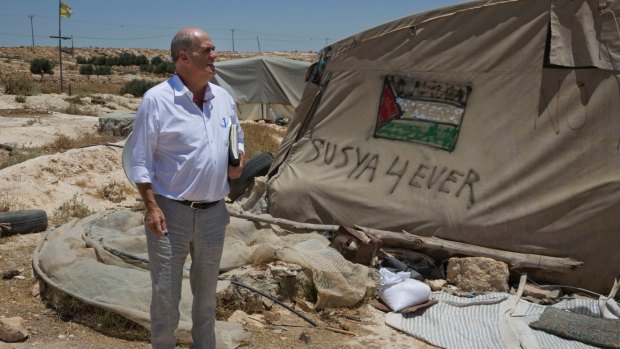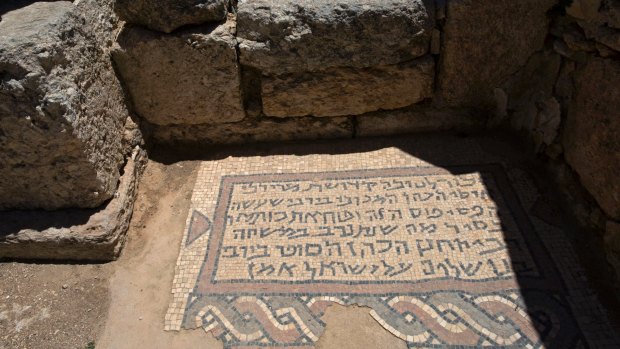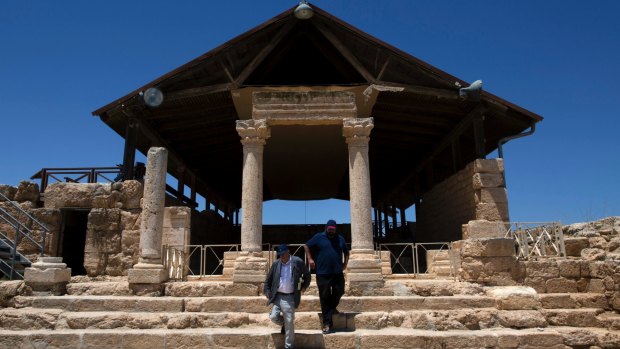This was published 8 years ago
As Julie Bishop prepares to visit the Holy Land, one village tells whole story
By William Booth
Susiya, Israeli-occupied West Bank: For a quick reality check on the current stalemate in the Israeli-Palestinian conflict, there's no better place to visit than this little village of miserable huts and sheep pens in the middle of nowhere.
The hamlet in the hills south of Hebron has become an improbable proxy in a cold war waged among Jewish settlers, the Israeli government, Western diplomats, peace activists and the 340 or so Arab herders who once inhabited caves on the site and now live in squalid tents.
Israel's military authority in the occupied West Bank wants to demolish the Palestinian community, contending that the ramshackle structures made of old tyres and weathered tarpaulins were built without permits and must come down.
The Palestinian residents insist they are not squatters but heirs to the land they have farmed and grazed since the Ottoman era. They say Israel wants to depopulate the area of Arabs and replace them with Jews.

Irish author Colm Toibin visits what remains of the Palestinian village of Susiya in the Israeli-occupied West Bank in July.Credit: AP
"It's ethnic cleansing," said Nasser Nawaja, a resident of the village, who is also employed by the Israeli human rights group B'Tselem, which opposes the demolition.
This is nonsense, said Josh Hasten, international director for the pro-settler group Regavim, which has been pushing the Israeli government to shove these "illegal squatters" off the land.
Mr Hasten described Susiya as part of a plot funded by the European Union and supported by the Palestinian Authority to assert rights that do not exist and create a "de facto Palestinian state" on land that should belong to Israel.
Most of the world considers the Jewish settlements on the West Bank to be illegal, a conclusion that the Israeli government rejects and which Foreign Minister Julie Bishop - who is about to visit Israel and the Palestinian territories before attending the launch of the EU-Australia Leadership Forum - has questioned.

Yehuda Shaul, left, co-founder of Israeli group Breaking The Silence, and Colm Toibin inspect a cave where 34-year-old Palestinian Nasser Nawaja said he was born.Credit: AP
The Nawaja clan are shepherds who have spent the past three decades subsisting with brackish cistern water and a trickle of power from a generator. They're not likely to leave unless forced at gunpoint.
"If we can stop the Israelis here, we can stop them from demolishing other villages," said Jihad Nawaja, one of the village elders.

A mosaic at the former location of a synagogue in the archaeological park adjacent to the West Bank village of Susiya.Credit: AP
A final order to bulldoze the hamlet was delayed in mid-August when Israeli Prime Minister Benjamin Netanyahu's office asked the courts to stay their ruling for two months - until after the US presidential election - according to lawyers involved in the case on both sides.
The Obama administration this month warned Israel that it finds the proposed eviction "very troubling".

Yehuda Shaul and Colm Toibin visit the archaeological park near the occupied West Bank village of Susiya.Credit: AP
In July, State Department spokesman John Kirby said that demolishing Susiya "would set a damaging standard for displacement and land confiscation, particularly given settlement-related activity in the area".
Susiya also stands at the centre of fraying relations between Israel and the European Union, which is providing life support to the village.
The solar panels in Susiya were donated by Germany, the school by Spain, the water pumps by Ireland. Belgium, Italy, Norway and others have contributed a playground, a shipping container to use as an office and a new bullhorn.
Even so, it is a pitiful place, without running water or electricity from the grid, though it lies just a few hundred metres from Israeli power and water lines that serve a nearby Jewish settlement with the same name.
Right-wing ministers in Mr Netanyahu's coalition government have become much more vocal in their calls for the EU to stay out of Israel's domestic affairs. Apparently, that is not going to happen.
This month, two top British diplomats visited Susiya to hear from the locals. Tony Kay, the deputy chief of mission at the British embassy to Israel in Tel Aviv, made Susiya a first stop just weeks after arriving in the country.
"The Israelis criticise the Palestinians for building without permits, but the number of permits the Palestinians are issued for Area C is practically nil," he said.
Area C is the 60 per cent of the West Bank completely controlled by the Israeli military, which oversees both security and civilian affairs there.
James Downer, the British deputy consul-general in Jerusalem, sipped coffee with the Nawaja clan. "I am very fond of Susiya," he said.
Mr Downer joked that he had visited enough times to be made an honorary citizen. He promised the locals: "We will do what we can to oppose demolitions here and elsewhere."
B'Tselem, citing government figures, reports that in 2014, out of 242 permit applications submitted by Palestinians for building in Area C, only one was granted. Between 2009 and 2012, a total of 1640 applications were submitted. Only 37 - about 2.3 per cent - were approved, according to the human rights group, which said that most Palestinians do not submit the paperwork unless they face "stop-work" orders.
The Palestinians want to create a state in the Gaza Strip and here on the West Bank, which Israel occupied after winning the 1967 Arab-Israeli war.
Israeli Agriculture Minister Uri Ariel, whose far-right Jewish Home party has strong support from settlers, has recently called on the government to formally annex Area C, where 200 Jewish settlements are located, saying that a two-state solution is unworkable.
Of the territories captured in 1967, Israel has annexed both East Jerusalem and the Golan Heights. Neither has been recognised internationally as Israeli territory.
Whatever it was in the past, these days Susiya has more of the feeling of a protest camp than a functioning Palestinian village.
There are no streets, shops or mosques, and no permanent homes. There do not seem to be many people, either - giving some support to Regavim's claim that most of the residents live in the nearby Palestinian town of Yatta.
Residents say that since the construction of a Jewish settlement nearby in 1983, their village has been levelled twice and partly demolished seven other times by Israeli bulldozers. Each time, the Palestinians returned to the hilltop and rebuilt their huts.
Israeli Justice Minister Ayelet Shaked, also a member of the Jewish Home party, visited the area this month and said it was hypocritical for the EU to fight against new building in Jewish settlements in the occupied West Bank while underwriting "illegal" construction in Palestinian villages.
As the Jewish settlements in the West Bank continue to grow, the Israeli military has ramped up demolitions of Palestinian homes, barns and sheds.
According to the United Nations, Israel has demolished 614 unauthorised Palestinian structures in the West Bank this year.
Israeli settlers in the West Bank see an insidious Palestinian encroachment onto lands the Jewish homesteaders believe were given to them by God.
Yochai Damari, who heads a regional council representing Jewish settlements in the Hebron hills, called the residents of Susiya "invaders" and a "criminal tribe".
"The matter has been debated and it was decided to evict them, after endless petitions and foot-dragging," he told the Israeli newspaper Haaretz.
Regavim, the group pushing to have the Palestinians evicted, says the herders of Susiya are also squatting on land adjacent to an important archaeological site with ruins of a Jewish community and a synagogue dating to the 8th century.
The same site also has remains of an ancient mosque, built on top of the synagogue.
Washington Post